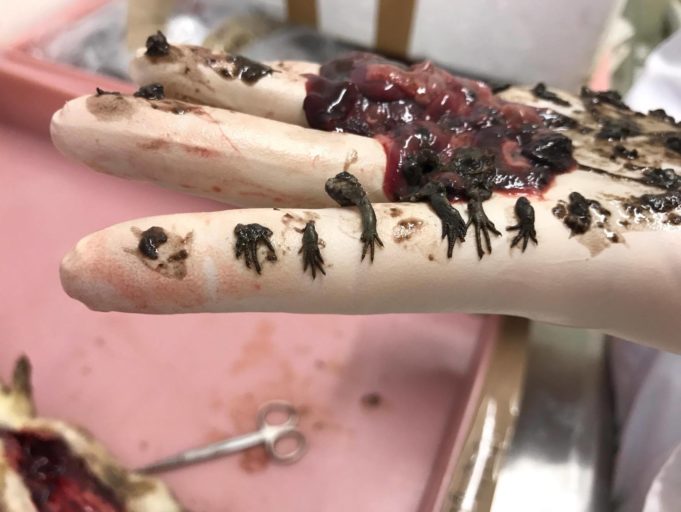Back in 2017, PFNZ Trust talked to Otago Zoology student Jamie McAulay about his Masters research on the diet of stoats. Well the Masters is done and dusted and Jamie’s thesis is now available online through the University’s ‘OUR Archive’ site. So what has Jamie found out?

The research project looked specifically at the diet of alpine stoats and several community groups helped out, providing Jamie with stoats that they’d trapped in their conservation areas.
“Stoats (Mustela erminea) are a significant predator of many alpine species, but their cryptic nature combined with the challenging working conditions of the alpine zone means no study has yet been able to apply spatial or temporal resolution to the study of stoat diet in alpine areas. As such, conservation managers currently lack information on predation feeding patterns, such as the factors that might drive greater or lesser consumption of threatened taxa by stoats.”
Finding out what those stoats had been eating was a fairly gruesome process.
“I trialled a novel technique to provide spatial and temporal (place and time) replication to the study of stoat diet in alpine areas. I examined the diet of 55 stoats caught in the alpine zone of three national parks of the South Island of New Zealand. In addition to examining stomach content, I conducted Stable Isotope Analysis using three stoat tissues (bone collagen, claw and liver). I examined isotopic signatures of stoat tissues against signatures of prey collected at each site (297 prey from four sites and two time periods).”

Both long-term and short-term diet estimates were able to be made because of the different types of body tissues being analysed. Individual variability in diet was also assessed in the research.
“Mice, ship rats and hares made up the largest portion of diet at all sites using long-term diet estimates from bone collagen. However, shorter-term estimates using claw tissue showed increased reliance on invertebrates during the summer period, supporting the hypothesis that stoats consume greater proportions of prey such as ground wētā (Hemiandrus spp) when these were seasonably more available.”
When lots of rats were around, the stoats’ diet consisted of a higher proportion of mammal prey.
“Ship rat abundance was strongly correlated with the proportion of mammals in the diet at all sites.”
Birds were also eaten, but the proportion of birds in the stoats’ diets varied in different regions.
“The proportion of birds in the diet at Fiordland and Mt Aspiring National Parks was amongst the lowest recorded anywhere in New Zealand but was greater at Nelson Lakes National Park, where they formed nearly a quarter of the metabolic requirements of stoats. This follows a trend seen at Nelson Lakes National Park where lesser consumption of mammals has resulted in greater predation of birds, invertebrates and skinks.”
Some individual stoats were also shown to specialise in their diet.

“Stoats at Nelson Lakes National Park exploited a wider range of food items than those at other sites and had a wider generalist niche. Despite this, individual stoats at this site did not have a more generalist diet and in fact were more specialised in the range of prey taken compared to other sites. This suggests individual specialisation of stoats within a generalist population niche, at least in some settings.”
So what does it mean and why does it matter?
“Control of invasive species leads to positive outcomes for many threatened species but, in very large ecosystem types, conservation managers must prioritise where to place limited resources to achieve the greatest conservation gain. The New Zealand alpine zone (area above the natural timberline) makes up ~11% of New Zealand and over 30% of the conservation estate. The probability of a species being preyed upon can be seen as a combination of the numeric and functional response of a predator to their environment: the abundance of predators and the per capita consumption of the prey type in question.”
That “per capita consumption” of prey by stoats can change – as seen in the increased seasonal consumption of weta and the increased regional consumption of birds at Nelson Lakes.
“Conservation managers should be aware of the potential for sudden and marked increases in per capita consumption of threatened alpine species by stoats. This is possibly linked to changes in abundance of mammalian prey such as ship rats. This is the first evidence to demonstrate individual specialisation within the diet of an introduced mammal at a landscape scale. This might explain accounts of episodic predation on threatened taxa and can be incorporated into management practices that aim to minimise the effects of invasive predators on species of conservation interest.”
Jamie’s research is the first study of stoat diet to use stable isotope analysis, but there is much still to be learned.
“This study is the first to assess stable isotope analysis as a tool for studying stoat diets and has produced credible results, highlighting the variability in the diets of stoats living in the alpine zone. While this study provides proof of concept that stable isotope analysis can provide useful information to inform management of invasive species in New Zealand, further research is needed to determine stoat specific enrichment factors, and to confirm the accuracy of indicative results presented here.”
The full Masters thesis is available online through Otago University’s OUR Archive website.
Using Stable Isotope Analysis to study the diet of stoats (Mustela erminea) in the alpine zone of New Zealand (2019)

